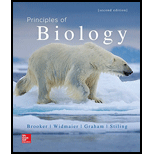
Concept explainers
According to the second law of
- energy cannot be created or destroyed.
- each energy transfer decreases the disorder of a system.
- energy is constant in the universe.
- each energy transfer increases the disorder of a system.
- chemical energy is a form of potential energy.
Introduction:
Thermodynamics is known as the branch of physics which provides information about the correlation between heat and other forms of energy.
Answer to Problem 1TY
The correct answer is option (d) each energy transfer increases the disorder of a system.
Explanation of Solution
Explanation/justification for the correct answer:
Option (d) Each energy transfer increases the disorder of a system. According to the second law of thermodynamics, the entropy or disorderedness always tends to increase in an isolated system. The disorderedness increases with transfer of energy. For example: when heat is provided to a single molecule of five-membered carbohydrate, it leads to the formation of five molecules of carbon dioxide, which is more disordered as compared to single-molecule. So, the correct answer is option (d).
Explanation for incorrect answer:
Option (a) energy cannot be created or destroyed. This is the first law of thermodynamics known as the law of conservation of energy, and not the second law of thermodynamics So, this is an incorrect answer.
Option (b) each energy transfer decreases the disorder of a system. The event of energy transfer increases the related disorderedness with it. The disorderedness does not decrease on energy transfer. So, this is an incorrect answer.
Option (c) energy is constant in the universe. It is the first law of thermodynamics, according to which the energy can neither be created nor be destroyed. As a result, the total amount of energy present in the universe remains constant. So, this is an incorrect answer.
Option (e) chemical energy is a form of potential energy. The chemical energy to be known as the form of potential energy that comes under the first law of thermodynamics, and not the second law. So, this is an incorrect answer.
According to the second law of thermodynamics, each energy transfer increases the disorder of a system. Hence, the correct answer is option (d) each energy transfer increases the disorder of a system.
Want to see more full solutions like this?
Chapter 6 Solutions
Principles of Biology
- What is behavioral adaptarrow_forward22. Which of the following mutant proteins is expected to have a dominant negative effect when over- expressed in normal cells? a. mutant PI3-kinase that lacks the SH2 domain but retains the kinase function b. mutant Grb2 protein that cannot bind to RTK c. mutant RTK that lacks the extracellular domain d. mutant PDK that has the PH domain but lost the kinase function e. all of the abovearrow_forwardWhat is the label ?arrow_forward
- Can you described the image? Can you explain the question as well their answer and how to get to an answer to an problem like this?arrow_forwardglg 112 mid unit assignment Identifying melting processesarrow_forwardGive only the mode of inheritance consistent with all three pedigrees and only two reasons that support this, nothing more, (it shouldn't take too long)arrow_forward
- Oarrow_forwardDescribe the principle of homeostasis.arrow_forwardExplain how the hormones of the glands listed below travel around the body to target organs and tissues : Pituitary gland Hypothalamus Thyroid Parathyroid Adrenal Pineal Pancreas(islets of langerhans) Gonads (testes and ovaries) Placentaarrow_forward
 Biology: The Dynamic Science (MindTap Course List)BiologyISBN:9781305389892Author:Peter J. Russell, Paul E. Hertz, Beverly McMillanPublisher:Cengage Learning
Biology: The Dynamic Science (MindTap Course List)BiologyISBN:9781305389892Author:Peter J. Russell, Paul E. Hertz, Beverly McMillanPublisher:Cengage Learning Biology Today and Tomorrow without Physiology (Mi...BiologyISBN:9781305117396Author:Cecie Starr, Christine Evers, Lisa StarrPublisher:Cengage Learning
Biology Today and Tomorrow without Physiology (Mi...BiologyISBN:9781305117396Author:Cecie Starr, Christine Evers, Lisa StarrPublisher:Cengage Learning
 Principles Of Radiographic Imaging: An Art And A ...Health & NutritionISBN:9781337711067Author:Richard R. Carlton, Arlene M. Adler, Vesna BalacPublisher:Cengage Learning
Principles Of Radiographic Imaging: An Art And A ...Health & NutritionISBN:9781337711067Author:Richard R. Carlton, Arlene M. Adler, Vesna BalacPublisher:Cengage Learning Biology (MindTap Course List)BiologyISBN:9781337392938Author:Eldra Solomon, Charles Martin, Diana W. Martin, Linda R. BergPublisher:Cengage Learning
Biology (MindTap Course List)BiologyISBN:9781337392938Author:Eldra Solomon, Charles Martin, Diana W. Martin, Linda R. BergPublisher:Cengage Learning Biology 2eBiologyISBN:9781947172517Author:Matthew Douglas, Jung Choi, Mary Ann ClarkPublisher:OpenStax
Biology 2eBiologyISBN:9781947172517Author:Matthew Douglas, Jung Choi, Mary Ann ClarkPublisher:OpenStax





